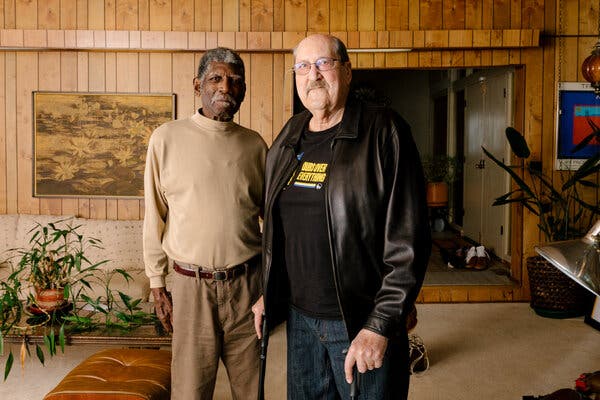OAKLAND, Calif. — On Sunday afternoon, Al Attles eased onto his living room couch next to his friend Tom Meschery, and they soon found themselves transported to March 2, 1962.
They were listening to an old radio broadcast, Meschery for the first time. For a few blissful minutes, Attles’s home in Oakland was filled with the smoky baritone of Bill Campbell, who was the play-by-play voice for the N.B.A.’s Philadelphia Warriors when Attles, 85, and Meschery, 83, were teammates.
“I remember thinking in the third quarter that something special was happening,” Meschery said.
That something special was Wilt Chamberlain, Philadelphia’s dominant center, scoring 100 points in a 169-147 win over the Knicks in Hershey, Pa., where Attles reveled in his role of shuffling the ball to Chamberlain as often as possible and Meschery helped make history amid a haze produced by the nearby candy factories.
“I can’t tell you how much the aroma of chocolate disturbed me for years,” he said.
On the game’s 60th anniversary, it lives on as a part of the country’s cultural fabric — a touchstone for a transcendent athlete when the N.B.A., by design, was predominantly white. Gary M. Pomerantz, whose book, “Wilt, 1962: The Night of 100 Points and the Dawn of a New Era,” offers the definitive account of the game, said Chamberlain’s performance marked an important shift.
“We remember Wilt’s 100-point game in part for its symbolism,” Pomerantz said in a telephone interview. “It symbolically exploded the racial quota N.B.A. owners had that limited opportunities for Black players. If this wasn’t the intended effect, it was the ultimate result: The N.B.A. would be a white man’s enclave no more.”
Attles, who was one of Philadelphia’s three Black players at the time, spent his entire 11-year career with the Warriors as a player and player-coach, then stayed with the franchise as its head coach, guiding the team, which had by then moved to California, to its first championship in 1975. He was enshrined in the Basketball Hall of Fame in 2019.
Meschery had 10 productive seasons in the N.B.A. before he embarked on a long second career as a high school English teacher. A published poet, he is the only former N.B.A. All-Star who has been inducted into the Nevada Writers Hall of Fame.
Yet for all their varied accomplishments, Attles and Meschery understand that their legacies are tied, in some small measure, to that night in Hershey, where Chamberlain shot 36 of 63 from the field, made 28 of 32 free throws, then caught a ride back to New York — he lived in Harlem at the time — with a couple of players from the woebegone Knicks.
“He was trying to sleep in the back, and he could overhear them talking about dropping him off by the side of the highway,” Meschery said, laughing.
The Great Read
More fascinating tales you can’t help but read all the way to the end.
- Disney World’s new “Star Wars” hotel incorporates role playing, live interactive theater, rides and gaming. But it will cost you.
- A Broadway conductor caught Covid in the first wave. Two despairing years later, he is finally reclaiming his old life, breath by breath.
- A violent brawl that involved several biker gangs in Waco, Texas, left nine dead and led to nearly 200 arrests. Why was no one convicted?
The game was, in many ways, unremarkable. It was staged at Hershey Sports Arena, an impersonal concrete shell where the Warriors played a few games each season. For their game against the Knicks, the building was only half full. The wooden court was originally designed for roller skating. The game was not televised, and only a couple of newspaper reporters made the two-hour trip from Philadelphia.
Even now, the radio broadcast is not made available for public consumption without prior approval by the league. (The Warriors provided Attles and Meschery with a copy of the fourth quarter so they could listen to it.)
But the game produced unexpected magic, and it has continued to be mythologized — fitting for a figure like Chamberlain, who did little to dispel the stories, real or imagined, about his life. Even to teammates, Pomerantz wrote, Chamberlain could seem detached and “beyond their reach,” though Attles was closer to him than most.
“Just a terrific person once you got to know him,” Attles said.
To Meschery, Chamberlain was more of a looming presence — at least at first. In 1957, as a high school senior in San Francisco, Meschery appeared on NBC’s “The Steve Allen Show,” along with the rest of the country’s high school and college all-American selections. As they gathered onstage, Meschery glanced over his shoulder.
“And Wilt is standing right above me,” Meschery recalled.
Chamberlain, who was dominating college defenders for Kansas, eventually left school early to play for the Harlem Globetrotters, then joined the Warriors in 1959. Attles, who thought he was bound for a teaching job at a junior high school in Newark, made the Warriors as a fifth-round pick in 1960, crafting a reputation as a defense-minded guard. (His nickname? The Destroyer.) A scrappy forward, Meschery joined the Warriors the following season.
“I was in Wonderland,” he said. “I was just this kid from the West Coast, and there I was, playing with Wilt Chamberlain for God’s sake.”
Meschery was prone to mixing it up with opponents. He recalled one game when Zelmo Beaty, a 6-foot-9 center for the St. Louis Hawks, lost his patience with him. They were about to brawl, Meschery said, when the 7-foot-1 Chamberlain wrapped his arms around Beaty and hauled him away as if he were a sack of potatoes.
“Wilt saved my life,” Meschery said.
Meschery has a memoir in the works, and he recently finished a short chapter on Chamberlain’s 100-point game. But Meschery said he had never heard the radio broadcast until Sunday, when he was transfixed by the soundtrack of a game from another era.
For Meschery and Attles, the broadcast stirred dusty memories. They remembered the way in which Dave Zinkoff, the team’s public address announcer, would enunciate Chamberlain’s nickname, the Big Dipper, in his hallmark Philadelphia drawl: “Dippah dunk!” They remembered the team’s exhaustive preseason schedule — 15 games or more in “Podunk towns,” Meschery said — as the N.B.A. sought to expand its reach. They remembered traveling by train to St. Louis from Philadelphia, long before the era of charter flights.
“Wilt played cards the whole time,” Meschery said.
They remembered how the team had arrived early for its game against the Knicks in Hershey, and how some of the players occupied themselves at a nearby penny arcade. Chamberlain was predictably the star attraction as he monopolized a target-shooting game.
“I don’t think he missed,” Meschery said.
And as they listened to Campbell’s call of the game, Meschery could even picture Frank McGuire, Philadelphia’s coach, patrolling the sideline in his crisp suit.
“Frank’s out there with his cuff links, looking good,” Meschery said.
McGuire had floated the idea that Chamberlain could score 100 points in a game. After all, Chamberlain had already poured in a record 78 points against the Los Angeles Lakers a few months prior, and he was averaging 50.2 points per game — while playing virtually every minute of every game.
“Wilt would get ticked if he got taken out,” Meschery said.
And when he was in, passing to him was usually the best option for his teammates. “If you were going to shoot, you better make it,” Attles recalled.
By the early minutes of the fourth quarter for this special game, Campbell’s voice grew expectant with each possession.
Chamberlain with a jumper from the circle — good!
“That jumper was not really Wilt’s strength,” Meschery said. “It was sort of a miracle. But the whole game was a miracle in a way.”
The kids are hollering out, “We want 100!”
“If you got the ball to Wilt, you stayed in the game,” Attles said.
Happy to be with you on this historic occasion. The big man of the Warriors, and the big man of the league, has 92 points.
“Wilt loved to set up on the left block and then use that finger roll when he came across the lane,” Meschery said.
And then, finally, a few minutes later: He made it! He made it! He made it!
“One hundred points,” Attles said.
“Astounding,” Meschery said.
The Warriors relocated to San Francisco the following season. The league, of course, began to change, too. Players like Chamberlain, Attles and Meschery helped create the foundation for what the N.B.A. has become — a global enterprise and a revenue-generating colossus.
Yet Chamberlain’s record remains intact, and neither Attles nor Meschery thinks anyone will break it. Kobe Bryant came the closest when he scored 81 points — with the benefit of the 3-point shot — for the Lakers in 2006.
When Chamberlain died of a heart attack in 1999, he was just 63. Attles called Meschery to share the news.
“I just couldn’t believe that he could die,” Meschery said. “I know that sounds very strange, but he always had that aura around him, that he was larger than life.”
Now, Attles and Meschery are the only surviving members of the Warriors who played in Chamberlain’s 100-point game. Meschery, who has multiple myeloma, said he had two weeks left of treatment.
“And then I’m going to live another 10 years,” he said.
On Sunday, he was simply happy to be with his friend as they revisited a chapter from their past, back when anything seemed possible.
“That,” Meschery said, “was an awful lot of fun.”




























